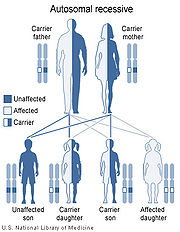
Mulibrey nanism
Encyclopedia
Mulibrey nanism also called Perheentupa syndrome and pericardial constriction with growth failure, is a rare autosomal
recessive congenital disorder
. It causes severe growth failure (dwarfism
) along with abnormalities of the heart, muscle, liver, brain and eye. Mulibrey nanism has been associated with a recessive defect in the gene TRIM37
. TRIM37 is responsible for various cellular functions including developmental patterning.

Mulibrey nanism is caused by mutations of the TRIM37 gene, located at human chromosome
17q22-23
. The disorder is inherited in an autosomal recessive manner. This means the defective gene responsible for the disorder is located on an autosome
(chromosome 17 is an autosome), and two copies of the defective gene (one inherited from each parent) are required in order to be born with the disorder. The parents of an individual with an autosomal recessive disorder both carry
one copy of the defective gene, but usually do not experience any signs or symptoms of the disorder.
. Worldwide, it has been documented in 110 persons, 85 of them Finnish. It is a recessive
genetic disease. Many people with Mulibrey nanism have parents who are closely related (consanguine). Signs and symptoms are variable. Siblings who suffer this disease sometimes do not share the same symptoms.
Autosome
An autosome is a chromosome that is not a sex chromosome, or allosome; that is to say, there is an equal number of copies of the chromosome in males and females. For example, in humans, there are 22 pairs of autosomes. In addition to autosomes, there are sex chromosomes, to be specific: X and Y...
recessive congenital disorder
Congenital disorder
A congenital disorder, or congenital disease, is a condition existing at birth and often before birth, or that develops during the first month of life , regardless of causation...
. It causes severe growth failure (dwarfism
Dwarfism
Dwarfism is short stature resulting from a medical condition. It is sometimes defined as an adult height of less than 4 feet 10 inches , although this definition is problematic because short stature in itself is not a disorder....
) along with abnormalities of the heart, muscle, liver, brain and eye. Mulibrey nanism has been associated with a recessive defect in the gene TRIM37
TRIM37
Tripartite motif-containing protein 37 is a protein that in humans is encoded by the TRIM37 gene.-Further reading:...
. TRIM37 is responsible for various cellular functions including developmental patterning.
Characteristics
A person with Mulibrey nanism has growth retardation, a short broad neck, misshapen sternum, small thorax, square shoulders, triangular face, unusual voice, enlarged liver, and yellowish dots in the ocular fundi. Individuals with Mulibrey nanism have also been reported to have mental retardation, tumors, and infertility.Cause and genetics

Mulibrey nanism is caused by mutations of the TRIM37 gene, located at human chromosome
Chromosome
A chromosome is an organized structure of DNA and protein found in cells. It is a single piece of coiled DNA containing many genes, regulatory elements and other nucleotide sequences. Chromosomes also contain DNA-bound proteins, which serve to package the DNA and control its functions.Chromosomes...
17q22-23
Chromosome 17 (human)
125px|rightChromosome 17 is one of the 23 pairs of chromosomes in humans. People normally have two copies of this chromosome. Chromosome 17 spans more than 81 million base pairs and represents between 2.5 and 3 % of the total DNA in cells.Identifying genes on each chromosome is an active area of...
. The disorder is inherited in an autosomal recessive manner. This means the defective gene responsible for the disorder is located on an autosome
Autosome
An autosome is a chromosome that is not a sex chromosome, or allosome; that is to say, there is an equal number of copies of the chromosome in males and females. For example, in humans, there are 22 pairs of autosomes. In addition to autosomes, there are sex chromosomes, to be specific: X and Y...
(chromosome 17 is an autosome), and two copies of the defective gene (one inherited from each parent) are required in order to be born with the disorder. The parents of an individual with an autosomal recessive disorder both carry
Genetic carrier
A genetic carrier , is a person or other organism that has inherited a genetic trait or mutation, but who does not display that trait or show symptoms of the disease. They are, however, able to pass the gene onto their offspring, who may then express the gene...
one copy of the defective gene, but usually do not experience any signs or symptoms of the disorder.
Natural history
A rare disease, Mulibrey nanism may be a Finnish heritage diseaseFinnish heritage disease
A Finnish heritage disease is a genetic disease or disorder that is part of the Finnish disease heritage. Finnish heritage diseases are significantly more common in people whose ancestors were ethnic Finns, natives of Finland and Sweden. About 40 rare diseases are regarded as Finnish heritage...
. Worldwide, it has been documented in 110 persons, 85 of them Finnish. It is a recessive
Recessive
In genetics, the term "recessive gene" refers to an allele that causes a phenotype that is only seen in a homozygous genotype and never in a heterozygous genotype. Every person has two copies of every gene on autosomal chromosomes, one from mother and one from father...
genetic disease. Many people with Mulibrey nanism have parents who are closely related (consanguine). Signs and symptoms are variable. Siblings who suffer this disease sometimes do not share the same symptoms.

